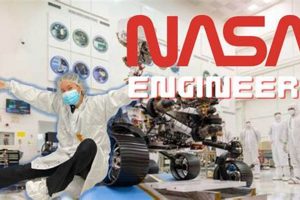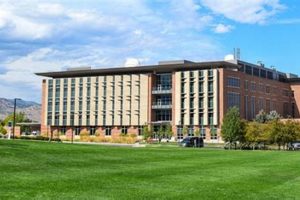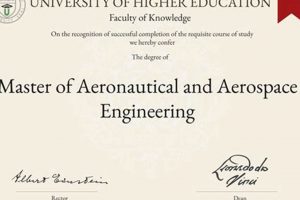A comparison of two distinct engineering disciplines, one focused on the design, development, and testing of aircraft and spacecraft, and the other on the creation and maintenance of software systems. Aerospace engineering applies principles of physics and engineering to create vehicles that operate within and beyond Earth’s atmosphere. Software engineering employs principles of computer science and engineering to build and maintain complex software applications.
Understanding the distinctions between these fields is important for individuals considering career paths and for organizations requiring specific engineering expertise. Historically, aerospace engineering has been driven by government and military needs, leading to advancements in flight and space exploration. Software engineering has evolved with the rapid growth of the technology industry, influencing virtually every sector from finance to healthcare.
The subsequent discussion will delve into the core responsibilities, required skills, typical work environments, compensation expectations, and future outlooks for professionals in both fields, providing a detailed examination of the differences and similarities between these two impactful careers.
The following points offer guidance for individuals weighing the options between careers focused on aeronautical and space vehicle design and those centered on software creation and maintenance. Careful consideration of personal aptitude, educational pathways, and professional aspirations is paramount.
Tip 1: Evaluate Foundational Interests. Individuals should assess their intrinsic interests in physics, mathematics, and mechanics versus computer science, algorithms, and data structures. Foundational interests are key to long-term engagement and success in either field.
Tip 2: Research Required Educational Pathways. Aerospace engineering typically necessitates a bachelor’s or master’s degree in aerospace engineering. Software engineering pathways are more varied, including computer science degrees, software engineering degrees, or related fields. Investigate specific program curricula and specializations.
Tip 3: Consider Desired Work Environment. Aerospace engineers often work in research laboratories, testing facilities, or manufacturing plants, interacting with physical prototypes and hardware. Software engineers frequently work in office environments, collaborating with teams remotely or in person, primarily interacting with digital code and systems.
Tip 4: Explore Specialization Options. Both fields offer a range of specializations. Aerospace engineering includes areas like aerodynamics, propulsion, and structural design. Software engineering offers paths such as web development, mobile app development, cybersecurity, and artificial intelligence.
Tip 5: Analyze Job Market Trends. Research current job market demands and future projections for both sectors. Government reports, industry publications, and professional organizations provide valuable data on employment opportunities and growth rates.
Tip 6: Assess Salary Expectations. Research the average salary ranges for entry-level and experienced professionals in both fields, considering regional variations and specific specializations. Compensation data is readily available from online resources and industry surveys.
Tip 7: Investigate Internship Opportunities. Seek out internships in both aerospace and software engineering to gain practical experience and determine which field aligns best with one’s skills and interests. Internships provide invaluable insights into day-to-day responsibilities and industry culture.
These considerations offer a framework for evaluating the suitability of a career in either aerospace or software engineering, emphasizing the importance of aligning personal strengths with the demands and opportunities within each field.
The subsequent section will provide a concluding overview, synthesizing the key differences and similarities between these engineering disciplines and offering a final perspective on career decision-making.
1. Vehicle/System Creation
Vehicle or system creation represents a fundamental divergence between the functions of aerospace engineers and software engineers. Aerospace engineers are primarily concerned with the design, development, and testing of tangible vehicles such as airplanes, helicopters, satellites, and spacecraft. This necessitates a deep understanding of aerodynamics, propulsion, structural mechanics, and materials science. A real-world example is the development of a new commercial airliner, where aerospace engineers are responsible for designing the wings, fuselage, and control systems to meet stringent performance and safety requirements. The creation of these physical vehicles is a complex, multidisciplinary effort that involves extensive prototyping, testing, and certification processes. This direct involvement in the creation of physical objects distinguishes this discipline from software engineering.
Conversely, software engineers focus on the creation of intangible systemssoftware applications, operating systems, embedded systems, and web platforms. They employ programming languages, data structures, algorithms, and software development methodologies to build functional software that meets specific requirements. An example of this is the development of an e-commerce platform, where software engineers are responsible for designing the database structure, implementing the user interface, and ensuring the security of transactions. While software engineers may interact with hardware indirectly, their primary focus is on the logic and functionality of the software itself. This abstract nature of system creation requires a different skill set, emphasizing problem-solving, logical reasoning, and attention to detail.
In summary, the contrast in vehicle/system creation highlights the core difference between these two engineering disciplines. Aerospace engineers create physical vehicles designed for operation in air and space, while software engineers develop virtual systems that operate within computer hardware. This distinction influences the required skills, tools, and work environments associated with each field, shaping the career paths of individuals in these roles. The understanding of these distinctions is practically significant for students and professionals considering which area of engineering best aligns with their interests and aptitudes.
2. Mathematical Foundations
Mathematical foundations represent a crucial differentiating factor between aerospace engineering and software engineering. While both disciplines rely heavily on mathematics, the specific mathematical areas of emphasis differ significantly, influencing the daily tasks and problem-solving approaches employed by professionals in each field. Aerospace engineers require a strong foundation in calculus, differential equations, linear algebra, and numerical methods. These mathematical tools are essential for analyzing fluid dynamics, structural mechanics, control systems, and orbital mechanics. For instance, calculating the trajectory of a spacecraft necessitates a thorough understanding of differential equations to model gravitational forces and orbital parameters. Similarly, finite element analysis, used to simulate stress and strain on aircraft components, is deeply rooted in linear algebra and numerical methods. A weak grasp of these mathematical concepts directly impedes an aerospace engineer’s ability to design safe and efficient aircraft and spacecraft.
Software engineers, conversely, require a robust understanding of discrete mathematics, including logic, set theory, graph theory, and combinatorics. These mathematical principles underpin the design of algorithms, data structures, and programming languages. For example, developing a secure encryption algorithm requires a firm understanding of number theory and modular arithmetic. Similarly, designing efficient search algorithms relies on concepts from graph theory and data structures. While calculus and differential equations might be relevant in certain specialized areas of software engineering, such as computer graphics or machine learning, they are not as central to the core curriculum as they are in aerospace engineering. The consequences of inadequate mathematical understanding in software engineering can manifest as inefficient algorithms, insecure systems, and unreliable software applications.
In summary, the specific mathematical tools employed within aerospace engineering versus software engineering highlight the distinct nature of the problems addressed in each field. Aerospace engineers rely on continuous mathematics to model physical phenomena, while software engineers utilize discrete mathematics to design logical systems. This difference in mathematical emphasis is a key consideration for individuals deciding between these two career paths, as it directly impacts the type of problems encountered and the problem-solving approaches used on a daily basis. Recognizing the practical significance of these mathematical foundations is essential for career satisfaction and professional success in either discipline.
3. Abstraction Levels
Abstraction levels represent a pivotal distinction when comparing aerospace and software engineering. Aerospace engineering necessitates engagement with tangible physical systems, demanding engineers to work with materials, forces, and environments directly. A design engineer crafting a wing structure must consider the physical properties of aluminum alloys, the aerodynamic forces acting upon the wing, and environmental factors such as temperature and pressure. The level of abstraction is relatively low, requiring a direct understanding of how physical laws govern the behavior of the system. Conversely, software engineering often operates at significantly higher levels of abstraction. Software engineers build systems by manipulating code, data structures, and algorithms, rarely interacting directly with the underlying hardware. For example, a software engineer designing a user interface manipulates abstract concepts like buttons, menus, and data fields, without needing detailed knowledge of the physical transistors within the computer’s processor. This higher level of abstraction allows software engineers to manage complexity effectively but also introduces potential disconnects from the underlying physical realities.
The difference in abstraction levels carries practical implications for the skills and knowledge required in each field. Aerospace engineers require a deep understanding of physics, materials science, and mechanical engineering principles to translate abstract designs into functional physical systems. They must be adept at using tools like computer-aided design (CAD) and finite element analysis (FEA) to model and simulate the behavior of physical systems. Software engineers require strong programming skills, knowledge of data structures and algorithms, and an understanding of software development methodologies. They use integrated development environments (IDEs) and version control systems to manage complex software projects. The higher level of abstraction in software engineering allows for rapid iteration and development cycles, while the lower level of abstraction in aerospace engineering demands more rigorous testing and validation procedures due to the inherent safety-critical nature of the systems.
In summary, abstraction levels significantly differentiate the roles of aerospace and software engineers. Aerospace engineers operate with relatively low levels of abstraction, engaging directly with physical systems and requiring a deep understanding of physical laws. Software engineers function at higher levels of abstraction, manipulating code and data structures to build complex software systems. This difference impacts the required skills, tools, and development processes in each field. A proper consideration of abstraction levels becomes key in career choices for upcoming engineers.
4. Team Dynamics
Team dynamics represent a significant point of contrast when considering aerospace engineering versus software engineering. Aerospace engineering projects, by their nature, often involve larger, more interdisciplinary teams. This is driven by the complexity inherent in designing, building, and testing aircraft or spacecraft. Such teams typically encompass specialists in aerodynamics, propulsion, materials science, structural analysis, and control systems, necessitating robust communication and coordination across diverse expertise areas. A real-world illustration is the development of a new satellite, where collaboration extends beyond engineers to include scientists, technicians, and project managers. Effective team functioning, therefore, is paramount for project success, requiring defined roles, clear communication channels, and established conflict resolution mechanisms. Conversely, software engineering projects, while also collaborative, can frequently be accomplished by smaller, more specialized teams. A software development team might consist of front-end developers, back-end developers, and database administrators. This smaller scale facilitates more agile development methodologies and rapid iteration cycles. Effective software engineering teams prioritize clear communication, version control, and continuous integration practices.
The scale and complexity of projects significantly affect the required team dynamic skills. Aerospace engineers must be adept at navigating complex hierarchies, integrating feedback from various disciplines, and adhering to stringent regulatory requirements. Software engineers, on the other hand, often work in more fluid and autonomous environments, emphasizing self-organization, peer review, and iterative development. A failure in team dynamics can have severe consequences in both fields. In aerospace engineering, miscommunication or lack of coordination can lead to critical design flaws or safety hazards. For example, incorrect data sharing between the aerodynamics and structural analysis teams could result in an unstable wing design. In software engineering, poor collaboration can result in software defects, missed deadlines, and compromised security. Consider a poorly managed software team where the frontend and backend developers had lack of communication, that cause many system bugs and broken UI/UX.
In conclusion, team dynamics constitute a vital component in differentiating between aerospace and software engineering. While both fields require effective teamwork, the scale, complexity, and management structures differ considerably. Aerospace engineering necessitates larger, interdisciplinary teams adhering to stringent regulations. Software engineering benefits from smaller, more agile teams prioritizing rapid iteration. An awareness of these differing team dynamics is crucial for individuals considering a career in either discipline, impacting the required skillset and collaborative approach. Individuals also need to consider and plan their path to success for these things.
5. Industry Focus
Industry focus is a key differentiator when evaluating aerospace engineering and software engineering careers. Aerospace engineering is primarily concentrated within the aerospace sector, including aircraft manufacturers, space exploration agencies, and defense contractors. Employment opportunities are heavily influenced by governmental spending, research and development budgets, and global air travel demands. For example, Boeing and Airbus employ numerous aerospace engineers in the design, testing, and manufacturing of commercial aircraft. NASA employs a substantial number for space exploration missions and research. Therefore, career prospects are often tied to the economic health and strategic priorities of these specific industries and governmental entities.
Software engineering, in contrast, permeates nearly every sector of the modern economy. Opportunities exist across diverse industries such as finance, healthcare, retail, entertainment, education, and transportation. Software engineers are needed to develop and maintain applications, systems, and infrastructure supporting a wide range of business functions. For example, financial institutions require software engineers to build secure online banking platforms and algorithmic trading systems. Healthcare organizations employ software engineers to develop electronic health record systems and medical imaging software. This widespread demand translates to a larger and more diversified job market for software engineers compared to aerospace engineers. Additionally, the rise of cloud computing, artificial intelligence, and cybersecurity has created new and rapidly growing opportunities for software engineering professionals.
In conclusion, industry focus exerts a significant influence on career trajectories in both aerospace and software engineering. Aerospace engineering remains concentrated within a relatively narrow set of industries, subject to cyclical economic trends and governmental policies. Software engineering offers broader employment prospects across a multitude of sectors, providing greater career flexibility and diversification. Understanding this distinction is crucial for individuals considering these career paths, allowing them to align their skills and interests with the demands and opportunities within specific industries. This has significant implication for professionals in career planning.
Frequently Asked Questions
The following questions and answers address common inquiries and misconceptions concerning the distinct career paths of aerospace and software engineering. They provide objective information to aid informed decision-making.
Question 1: Is an aerospace engineering degree a prerequisite for working in the aerospace industry?
While an aerospace engineering degree is highly advantageous, entry into the aerospace industry is also possible with degrees in mechanical engineering, electrical engineering, or computer science, provided relevant skills and experience are demonstrated.
Question 2: Does software engineering exclusively involve coding?
No, software engineering encompasses a broader range of activities, including requirements analysis, system design, testing, project management, and quality assurance. Coding is a significant, but not exclusive, component.
Question 3: Which career path offers greater job security?
Job security varies based on economic conditions and industry trends. Software engineering currently benefits from high demand across various sectors. Aerospace engineering can be more susceptible to fluctuations in government spending and defense contracts.
Question 4: Can skills learned in software engineering be applied to aerospace engineering and vice versa?
Yes, there is potential for skill transfer. Software engineering principles, such as embedded systems development and data analysis, are increasingly relevant in aerospace. Conversely, project management and systems thinking skills from aerospace can benefit software engineering projects.
Question 5: Which field generally offers higher earning potential?
Earning potential depends on experience, specialization, and location. Senior software engineers in high-demand areas, such as Silicon Valley, may earn more than many aerospace engineers. However, specialized roles in aerospace, like propulsion engineers, can also command high salaries.
Question 6: Is a graduate degree necessary for career advancement in either field?
A graduate degree is not always mandatory, but it can significantly enhance career advancement opportunities in both aerospace and software engineering. It allows for specialization and deeper technical expertise.
These FAQs aim to clarify key considerations when comparing the career paths of aerospace and software engineering, highlighting the nuances and complexities involved in making an informed decision.
The subsequent section will summarize the key distinctions and similarities between these engineering disciplines, offering a conclusive perspective on navigating career choices.
Aerospace Engineer vs. Software Engineer
The preceding exploration has illuminated the distinct characteristics of the aerospace engineer vs software engineer career paths. The analysis has detailed the divergent focuses on physical vehicles versus virtual systems, the varying mathematical foundations underpinning each discipline, the differing levels of abstraction involved in their respective tasks, the contrasting team dynamics inherent in project execution, and the disparate industry landscapes that define their professional environments. These points of comparison serve to highlight the fundamental differences that shape the daily activities and long-term career trajectories of professionals in each field.
Ultimately, the choice between pursuing a career as an aerospace engineer or a software engineer requires careful consideration of individual aptitudes, interests, and career aspirations. A thorough assessment of one’s strengths, coupled with a realistic understanding of the demands and opportunities within each field, is essential for making an informed decision. Further research, including internships and informational interviews, can provide valuable insights to guide this critical career choice. The future of both fields holds promise, driven by technological advancements and evolving societal needs, rewarding those who embrace lifelong learning and adapt to the changing demands of the engineering profession.







